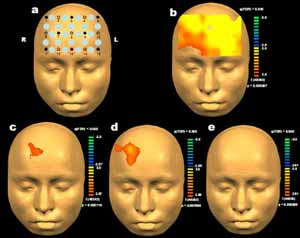The neuroscience of creativity and insight
Have you ever wondered what was going on in that noggin of yours when on that rare occasion you had an "aha!" moment or found yourself in a creative flow state, where even your screaming girlfriend couldn't snap you out of? Well Dietrich and Kanso over at the American University of Beirut seem to have mapped out the phenomena for us nicely. However, it's not quite as simple as you think.
In their review paper published in this month's Psychological Bulletin, they cover three broad categories related to insight and creativity. They are divergent thinking, artistic creativity, and insight. All studies reviewed used either electroencephalography, event-related potential, or neuroimaging.
The first category they looked at was divergent thinking, the thought process or method used to generate creative ideas by exploring many possible solutions. An example would be furiously brainstorming something interesting to write about on this darn blog. They found that numerous studies using the divergent thinking paradigm had one thing in common, that subjects exhibited some kind of diffuse prefrontal activation. Oddly enough, there was evidence for both increases and decreases in prefrontal activation depending on the study. They suggest that maybe different types of creativity were being tapped into.

In their review paper published in this month's Psychological Bulletin, they cover three broad categories related to insight and creativity. They are divergent thinking, artistic creativity, and insight. All studies reviewed used either electroencephalography, event-related potential, or neuroimaging.
The first category they looked at was divergent thinking, the thought process or method used to generate creative ideas by exploring many possible solutions. An example would be furiously brainstorming something interesting to write about on this darn blog. They found that numerous studies using the divergent thinking paradigm had one thing in common, that subjects exhibited some kind of diffuse prefrontal activation. Oddly enough, there was evidence for both increases and decreases in prefrontal activation depending on the study. They suggest that maybe different types of creativity were being tapped into.
Courtesy of Park Lab
Interestingly, people with schizophrenia show reduced prefrontal activation when performing divergent thinking tasks (Takeshi, 2010).
The next category the team covered was artistic creativity. In a particular series of studies, subjects were asked to mentally compose music, visualize abstract concepts, look at paintings, and imagine previously shown drawings; all under EEG monitoring. Activation of motor and temporalparietal regions were evident.
The last category discussed was insight. Reviewing the literature they found that the anterior cingulate cortex, involved in early learning and problem solving, was activated by insight problems and that the superior temporal gyrus, involved in the perception of facial expressions, was activated only when successful solutions to those insight problems were found. What is the sound of one hand clapping?!
The take home message Dietrich and Kanso emphasize is that no single brain area, nor a particular hemisphere for that matter, is involved in creativity or insight (contrary to popular belief). The next time your hipster artist friends tell you they're more "right brain" than anything else you can politely correct them by explaining...
I highly recommend you check out the article as there is a lot I did not cover.
References:
Dietrich A, & Kanso R (2010). A review of EEG, ERP, and neuroimaging studies of creativity and insight. Psychological bulletin, 136 (5), 822-48 PMID: 20804237
Takeshi K, Nemoto T, Fumoto M, Arita H, & Mizuno M (2010). Reduced prefrontal cortex activation during divergent thinking in schizophrenia: A multi-channel NIRS study. Progress in neuro-psychopharmacology & biological psychiatry PMID: 20673784
The next category the team covered was artistic creativity. In a particular series of studies, subjects were asked to mentally compose music, visualize abstract concepts, look at paintings, and imagine previously shown drawings; all under EEG monitoring. Activation of motor and temporalparietal regions were evident.
intense looking motor homunculus
The last category discussed was insight. Reviewing the literature they found that the anterior cingulate cortex, involved in early learning and problem solving, was activated by insight problems and that the superior temporal gyrus, involved in the perception of facial expressions, was activated only when successful solutions to those insight problems were found. What is the sound of one hand clapping?!
The take home message Dietrich and Kanso emphasize is that no single brain area, nor a particular hemisphere for that matter, is involved in creativity or insight (contrary to popular belief). The next time your hipster artist friends tell you they're more "right brain" than anything else you can politely correct them by explaining...
I highly recommend you check out the article as there is a lot I did not cover.
References:
Dietrich A, & Kanso R (2010). A review of EEG, ERP, and neuroimaging studies of creativity and insight. Psychological bulletin, 136 (5), 822-48 PMID: 20804237
Takeshi K, Nemoto T, Fumoto M, Arita H, & Mizuno M (2010). Reduced prefrontal cortex activation during divergent thinking in schizophrenia: A multi-channel NIRS study. Progress in neuro-psychopharmacology & biological psychiatry PMID: 20673784

